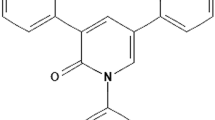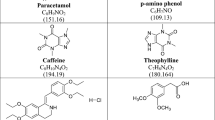Abstract
Spiramycin (SPY) is an antibiotic belonging to the class of macrolides. Its main structurally related components are SPY I, SPY II and SPY III. The aim of this work was to optimize and validate a simple and fast method of quantification of SPY I in tablets in the presence of SPYs II and III by HPLC based on multivariate approach. Initially, different conditions were tested by means of a complete factorial design 23. Afterward, the chromatographic parameters were optimized using the Doehlert Matrix and response surface methodology, which allowed to obtain an efficient separation for SPY I with relatively short retention time (16 min). The new method was validated using phosphoric acid 0.1% and methanol (67:33, v/v) as mobile phase, flow rate at 1.0 mL min−1, C8 column (250 mm × 4.6 mm × 5 µm) as stationary phase and UV detection at 232 nm. The method proved to be selective, linear, accurate, with good reproducibility, robust, useful, simple, and efficient for the quantification of SPY I in pharmaceutical tablets. Thus, multivariate approach proved to be an excellent strategy for method optimization with a reduced number of experiments without the need for additional cost with expensive equipment or chromatographic columns.



Similar content being viewed by others
References
Council of Europe (2017) European pharmacopeia, 6th edn. Council of Europe, Strasbourg
Mourier P, Brun A (1997) Study of the metabolism of spiramycin in pig liver. J Chromatogr B. https://doi.org/10.1016/S0378-4347(97)00477-5
Horie M, Saito K, Hoshino Y, Nakazawa H, Nose N (1988) Determination of spiramycin components in pharmaceutical preparations by HPLC. Bunseki Kagaku. https://doi.org/10.2116/bunsekikagaku.37.11_580
Sagan C, Salvador A, Dubreuil D, Poulet PP, Duffaut D, Brumpt I (2005) Simultaneous determination of metronidazole and spiramycin I in human plasma, saliva and gingival crevicular fluid by LC–MS/MS. J Pharm Biomed Anal. https://doi.org/10.1016/j.jpba.2004.12.033
Lin Q, Kahsay G, de Wall T, Zhu P, Tam M, Teughels R, Wang W, Van Schepdael AV, Adams E (2018) Improved liquid chromatographic method for quality control of Spiramycin using superficially porous particles. J Pharm Biomed Anal. https://doi.org/10.1016/j.jpba.2017.10.041
Liu L, Roets E, Hoogmartens J (1997) Liquid chromatography of spiramycin on poly(styrene-divinylbenzene). J Chromatogr A. https://doi.org/10.1016/S0021-9673(96)00876-X
Chepkwony HK, Vermaelen A, Roets E, Hoogmartens J (2001) Development and validation of a reversed-phase liquid chromatographic method for analysis of spiramycin and related substances. Chromatogr. https://doi.org/10.1007/BF02491832
National Center for Biotechnology Information (2021). PubChem Compound Summary for CID 5289394, Spiramycin. https://pubchem.ncbi.nlm.nih.gov/compound/Spiramycin. Accessed 29 Nov 2021
Avci ME, Arslan F, Çiftçi S, Ekiz A, Tüten A, Yildirim G, Madazli R (2016) Role of spiramycin in prevention of fetal toxoplasmosis. J Matern Fetal Neonatal Med. https://doi.org/10.3109/14767058.2015.1074998
Chambers HF, Mac-Dougall C (2017) Protein synthesis inhibitors and miscellaneous antibacterial agents. In: Brunton LL, Hilal-Dandan R, Knollmann BC (eds) Goodman & Gilman’s: The pharmacological basis of therapeutics, 13th edn. McGraw-Hill Education, New York
Calcagnile M, Bettini S, Damiano F, Talà A, Tredici SM, Pagano R, Di Salvo M, Siculella L, Fico D, De Benedetto GE, Valli L, Alifano P (2018) Stimulatory effects of methyl-β-cyclodextrin on spiramycin production and physical–chemical characterization of nonhost@guest complexes. ACS Omega. https://doi.org/10.1021/acsomega.7b01766
Poulsen SM, Kofoed C, Vester B (2000) Inhibition of the ribosomal peptidyl transferase reaction by the mycarose moiety of the antibiotics carbomycin, Spiramycin and tylosin. J Mol Biol. https://doi.org/10.1006/jmbi.2000.4229
Golan DE, Tashjian Junior AH, Armstrong EJ, Armstrong AW (2009) Princípios de farmacologia: A base fisiopatológica da farmacoterapia, 2nd edn. Guanabara Koogan, Rio de Janeiro
Brunton LL, Chabner BA, Knollmann BC (2012) As Bases Farmacológicas da Terapêutica de Goodman & Gilman, 12th edn. McGraw-Hill Education, New York
Pendela M, Govaerts C, Diana J, Hoogmartens J, Van Schepdael A, Adams E (2007) Characterization of impurities in spiramycin by liquid chromatography/ion trap mass spectrometry. Rapid Commun Mass Spectrom. https://doi.org/10.1002/rcm.2868
Civitareale C, Fiori M, Ballerini A, Brambilla G (2004) Identification and quantification method of spiramycin and tylosin in feeding stuffs with HPLC-UV/DAD at 1 ppm level. J Pharm Biomed Anal. https://doi.org/10.1016/j.jpba.2004.06.010
García-Mayor MA, Garcinuño RM, Fernández-Hernando P, Durand-Alegría JS (2006) Liquid chromatography-UV diode-array detection method for multi-residue determination of macrolide antibiotics in sheep’s milk. J Chromatogr A. https://doi.org/10.1016/j.chroma.2006.04.019
Wang J, Leung D (2009) Determination of spiramycin and neospiramycin antibiotic residues in raw milk using LC/ESI-MS/MS and solid-phase extraction. J Sep Sci. https://doi.org/10.1016/j.chroma.2006.04.019
García Mayor MA, Paniagua González G, Garcinuño Martínez RM, Fernández Hernando P, Durand Alegría JS (2017) Synthesis and characterization of a molecularly imprinted polymer for the determination of spiramycin in sheep milk. Food Chem. https://doi.org/10.1016/j.foodchem.2016.11.114
Zhou W, Ling Y, Liu T, Zhang Y, Li J, Li H, Wu W, Jiang S, Feng F, Yuan F, Zhang F (2017) Simultaneous determination of 16 macrolide antibiotics and 4 metabolites in milk by using Quick, Easy, Cheap, Effective, Rugged, and Safe extraction (QuEChERS) and high performance liquid chromatography tandem mass spectrometry. J Chromatogr B. https://doi.org/10.1016/j.jchromb.2017.07.046
Decheng S, Peilong W, Yang L, Ruiguo W, Shulin W, Zhiming X, Su Z (2018) Simultaneous determination of antibiotics and amantadines in animal-derived feedstuffs by ultraperformance liquid chromatographic-tandem mass spectrometry. J Chromatogr B. https://doi.org/10.1016/j.jchromb.2018.07.025
Liu H, Lin T, Lin X, Shao J, Li Q (2018) QuEChERS with magnetic hydrophilic-lipophilic balanced adsorbent and its application in multi-class veterinary residues in milk by ultra high-performance liquid chromatography-tandem mass spectrometry. Chromatogr. https://doi.org/10.1007/s10337-017-3433-9
Dow J, Lemar M, Frydman A, Gaillot J (1985) Automated high-performance liquid chromatographic determination of spiramycin by direct injection of plasma, using column-switching for sample clean-up. J Chromatogr B. https://doi.org/10.1016/s0378-4347(00)82028-9
Carlhant D, Le Bot MA, Guedes Y, Riche C, Mimouri F, Colin J, Berthou F (1989) Solid phase extraction and HPLC determination of spiramycin in plasma and vitreous concentrations. Biomed Chromatogr. https://doi.org/10.1002/bmc.1130030102
Elkhoudary MM, Abdel Salam RA, Hadad GM (2016) Development and Optimization of HPLC analysis of metronidazole, diloxanide, spiramycin and clioquinol in pharmaceutical dosage forms using experimental design. J Chrom Sci. https://doi.org/10.1093/chromsci/bmw126
Maher HM, Youssef RM (2009) Development of validated chromatographic methods for the simultaneous determination of metronidazole and spiramycin in tablets. Chromatographia. https://doi.org/10.1365/s10337-008-0865-2
Katsidzira RM, Wessels A, Aucamp M (2016) A novel RP-HPLC method for the detection and quantification of clarithromycin or spiramycin in bulk drug samples and dosage forms. Int J Pharm Pharm Sci. https://doi.org/10.22159/ijpps.2016v8i12.15058
Mahmoudi A, de Francia S, Boukhechem MS, Pirro S (2016) Quantification of three macrolide antibiotics in pharmaceutical lots by HPLC: development, validation and application to a simultaneous separation. Br J Pharm. https://doi.org/10.5920/bjpharm.2016.03
Ferreira SLC, Dos Santos WNL, Quintella CM, Neto BB, Bosque-Sendra JM (2004) Doehlert matrix: a chemometric tool for analytical chemistry-review. Talanta. https://doi.org/10.1016/j.talanta.2004.01.015
Montgomery DC, Myers RH (2002) Response surface methodology: process and product optimization using designed experiments, 2nd edn. Wiley, New York
Derringer G, Suich R (1980) Simultaneous optimization of several response variables. J Qual Technol. https://doi.org/10.1080/00224065.1980.11980968
Validation of analytical procedures: text and methodology Q2(R1) (2005) International conference on harmonisation of technical requirements for registration of pharmaceuticals for human use (ICH). https://database.ich.org/sites/default/files/Q2%28R1%29%20Guideline.pdf. Accessed 29 Nov 2021
Analytical procedures and methods validation for drugs and biologics (2015) Food and Drug Administration (FDA). https://www.fda.gov/files/drugs/published/Analytical-Procedures-and-Methods-Validation-for-Drugs-and-Biologics.pdf. Accessed 29 Nov 2021
Resolution of the collegiate board – RDC N° 166. Providing for the validation of analytical methods and other provisions (2017) The Brazilian Health Regulatory Agency (ANVISA). http://antigo.anvisa.gov.br/documents/10181/2721567/RDC_166_2017_COMP.pdf/d5fb92b3-6c6b-4130-8670-4e3263763401. Accessed 29 Nov 2021
National Formulary (2017) The United States Pharmacopeia, 37th edn. Rockville, The National Formulary
Youden WJ, Steiner EH (1975) Statistical manual of AOAC. Association of Official Analytical Chemistry, Washington
Faria AM, Jardim ICSF, Collins CH (2009) Effects of different high pH solutions on the chemical stability of immobilized-polymer stationary phases. J Chromatogr Sci. https://doi.org/10.1093/chromsci/47.9.734
Claessens HA, Van Straten MA, Kirkland JJ (1996) Effect of buffers on silica-based column stability in revesed-phase high-performance liquid chromatography. J Chromatogr A. https://doi.org/10.1016/0021-9673(95)00904-3
Gomes KA. Santos ALR, Faria AM (2020) Avaliação de aditivos de fase móvel e temperatura na vida útil de colunas para cromatografia líquida de alta eficiência. Quím Nova. https://doi.org/10.21577/0100-4042.20170482
Teófilo RF, Ferreira MMC (2006) Quimiometria II: planilhas eletrônicas para cálculos de planejamentos experimentais, um tutorial. Quím Nova. https://doi.org/10.1590/S0100-40422006000200026
Acknowledgements
This study was financed in part by the Coordenação de Aperfeiçoamento de Pessoal de Nível Superior—Brazil (CAPES)—Finance Code 001. The authors thank FAPEMIG for the financial support and are also grateful to the Federal University of Alfenas (Unifal-MG) and the Laboratory for Quality Control (NCQ) for the technical support and resources made available to carry out the work.
Author information
Authors and Affiliations
Corresponding author
Ethics declarations
Conflict of interest
The authors declare that they have no conflict of interest.
Additional information
Publisher's Note
Springer Nature remains neutral with regard to jurisdictional claims in published maps and institutional affiliations.
Supplementary Information
Below is the link to the electronic supplementary material.
Rights and permissions
About this article
Cite this article
dos Santos, R.A., dos Santos, L.A., de Araújo, M.B. et al. Multivariate Optimization and Validation of HPLC Method for Determination of Spiramycin I in Tablets. Chromatographia 85, 421–431 (2022). https://doi.org/10.1007/s10337-022-04153-z
Received:
Revised:
Accepted:
Published:
Issue Date:
DOI: https://doi.org/10.1007/s10337-022-04153-z





